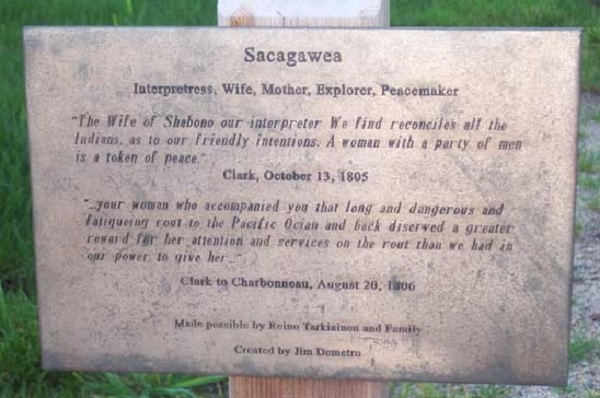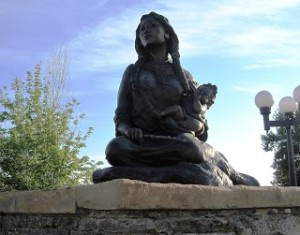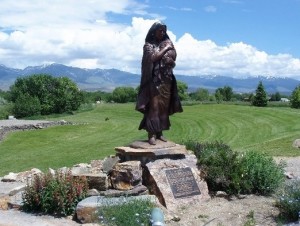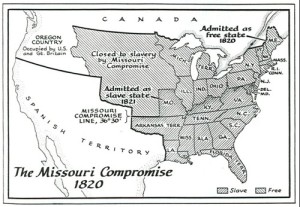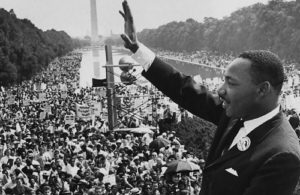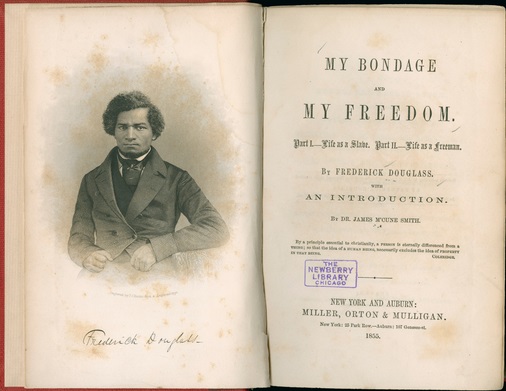Before the centennial of the Lewis and Clark expedition little was known about Sacagawea. A book published in 1902 by Eva Emery Dye; The Conquest: The True Story of Lewis and Clark popularized her image as that of a heroine who guided the expedition to success. Activist for women’s rights adopted Sacagawea’s image as a symbol of fortitude and importance of women in American history. Many statues, monuments, memorials, schools, community organizations and geographical landmarks have been named after this Native American heroine.
The following are some of the historical landmarks erected in honor of Sacagawea. Some monuments spell her name Sacagawea, others Sakakawea or Sacajawea.
Washington Park, Portland, Oregon
The first of Sacagawea’s many monuments; this one is made in bronze and was unveiled at the Lewis and Clark exhibition in 1905 in Portland to commemorate the centennial anniversary of the Lewis and Clark Expedition. The statue was designed by Alice Cooper. The National American Women’s Suffrage Association raised the funds to build the statue.

Sacajawea Park at Three Forks, Montana
A statue erected in honor of Sacajawea is located in a park that bears her name. The statue is called “Coming Home” and it is built in the area where Sacajawea was abducted as a young girl and taken to Mandan lands. The sculptor is Mary Michael.
The plaque reads: “An Indian woman whose heroic courage, steadfast devotion and splendid loyalty in acting as Guide across the Rocky Mountains made it possible for the Lewis and Clark Expedition (1804-1806) to occupy so important a place in the history of this Republic”.
Kansas City monument Lewis and Clark and Sacagawea
This sculpture is named “The Corps of Discovery” and was created by Eugene Daub in 2000 as part of the urban renewal of downtown Kansas City. It is located in Case Park at Clark’s Point. It portrays Lewis, Clark, Sacagawea and her son, Jean Baptiste, on her back; and opposite to Sacagawea is York, an African American slave who was also part of the expedition. This is the largest sculpture to date, 18 feet in height, built in honor of this group of explorers.
Sacajawea Memorial Area at Lemhi Pass
Located on the boundary of Montana and Idaho, Lemhi Pass is a National Historic Landmark managed by the National Forest Service where visitors can hike the Lewis and Clark National Historic Trail. The memorial area was created in 1932 to honor Sacajawea for her role in the success of the Lewis and Clark Expedition. The Daughters of the American Revolution (DAR), a national women’s service organization, founded in 1890, helped create the Sacajawea Memorial area at Lemhi Pass.
Sacagawea Interpretive, Educational and Events Center in Lemhi River Valley
This center is dedicated to providing education and information about the Native American heroine and her role in the Corps of Discovery expedition. Located in the Lemhi River Valley where Sacagawea was born around 1788, the center provides an outdoor school of discovery, visitor’s center, an amphitheater, community garden and a research library.
Clatsop national Memorial in Astoria, Oregon
In the winter of 1805-06 the Corps of Discovery built a fort in this very place where they found shelter from the winter cold. The expedition stayed until March 1806 when they headed back east. A replica of the fort was built in the original site in 1955 but was destroyed by fire in 2005. It was rebuilt the following year. The Clatsop National Memorial is part of the Lewis and Clark National Historical Park and managed by the National Park Service. A life size bronze statue named “Sacagawea and Baby” is located outside the visitor center. The creator of the statue was Jim Demetro.
Wind River Indian Reservation, Wyoming
The alleged burial site of Sacagawea is located in the cemetery in the Wind River Indian Reservation. The inscription on the gravestone dates Sacagawea’s death as April 9, 1884. According to oral tradition, a woman named Porivo and only recorded as “Bazil’s mother” is buried on the site. According to stories passed on orally Sacagawea had left her husband Toussaint Charbonneau and fled to Wyoming in the 1860s.
Marker of Sacagawea’s death in Mobridge, South Dakota
The controversy of the death of Sacagawea continues to this date. The marker in Mobridge, North Dakota honors Sacagawea as a member of the Shoshone tribe and for her contribution to the Corps of Discovery expedition. This marker dates her death as December 20, 1812 and states that her body must be buried somewhere near the site of old Fort Manuel located 30 miles north of the marker.
Click image to enlarge
Next – Biography of Sacagawea >>